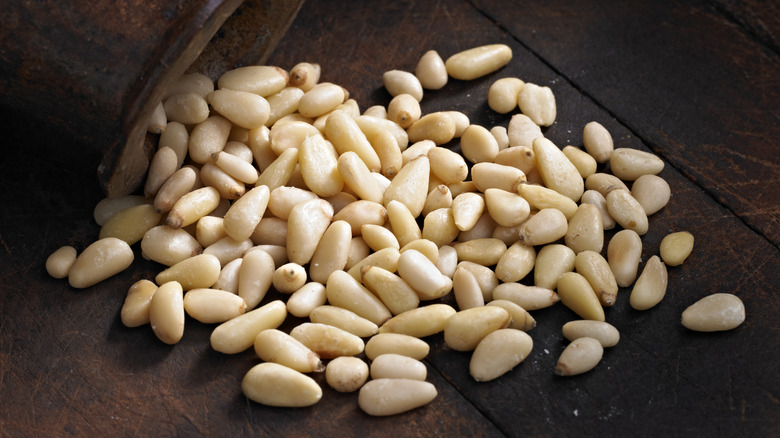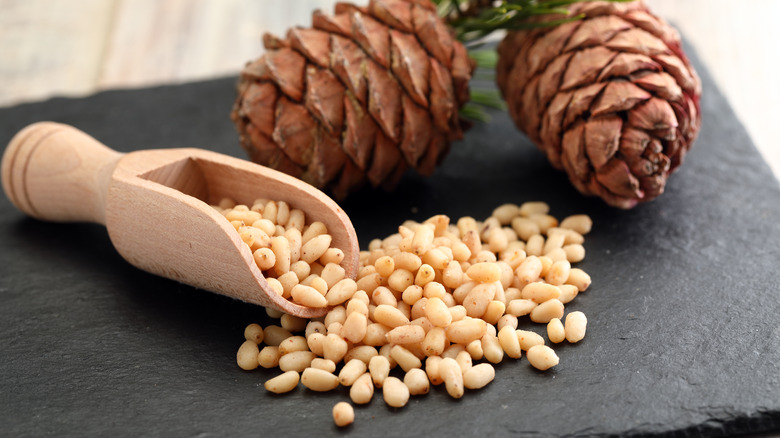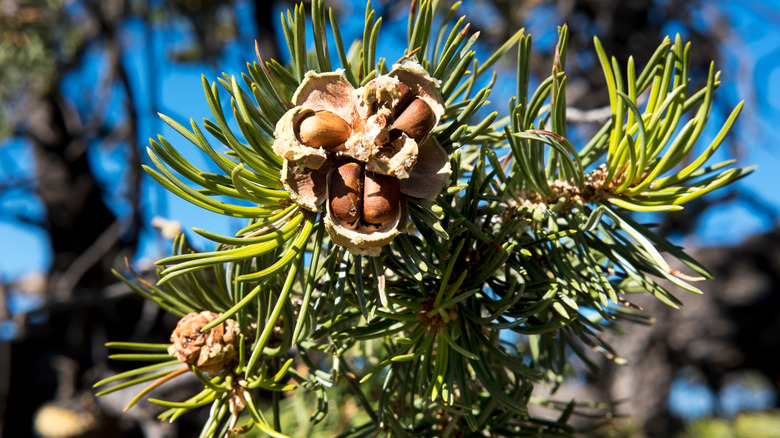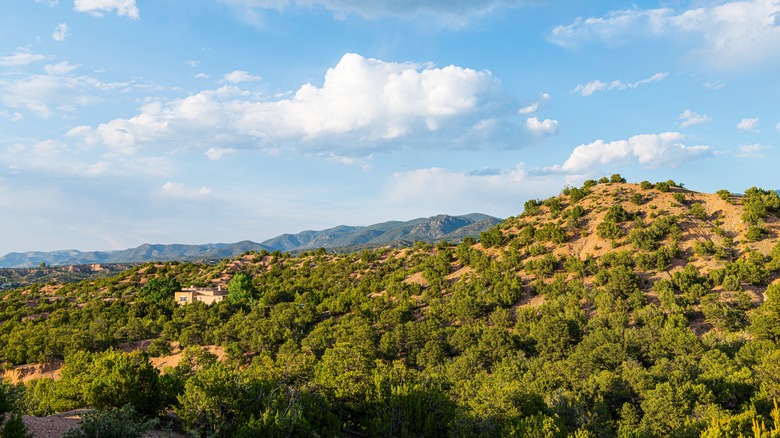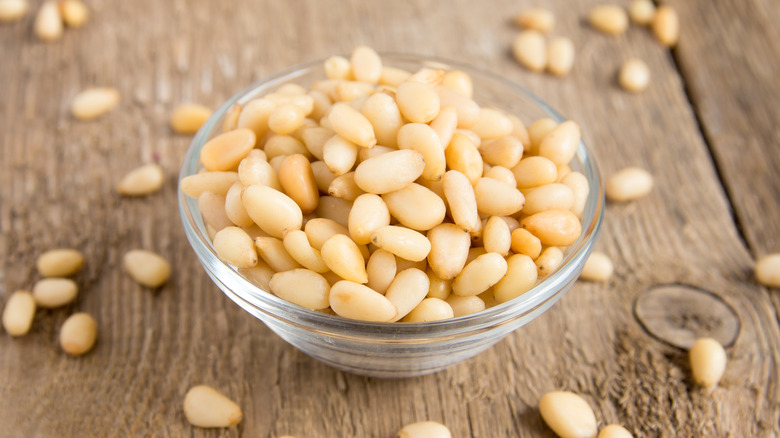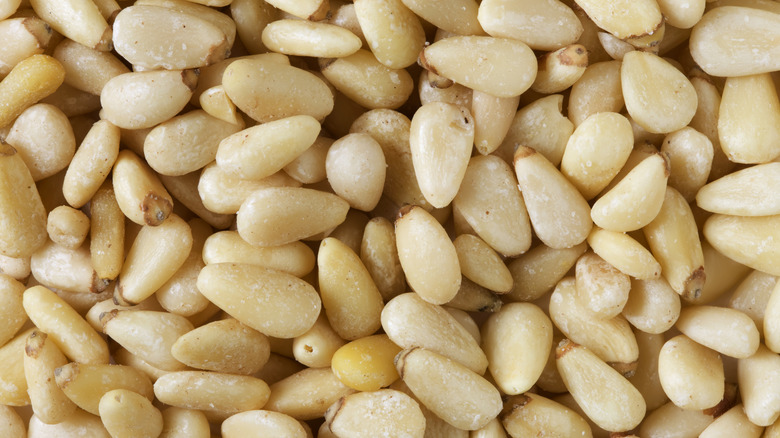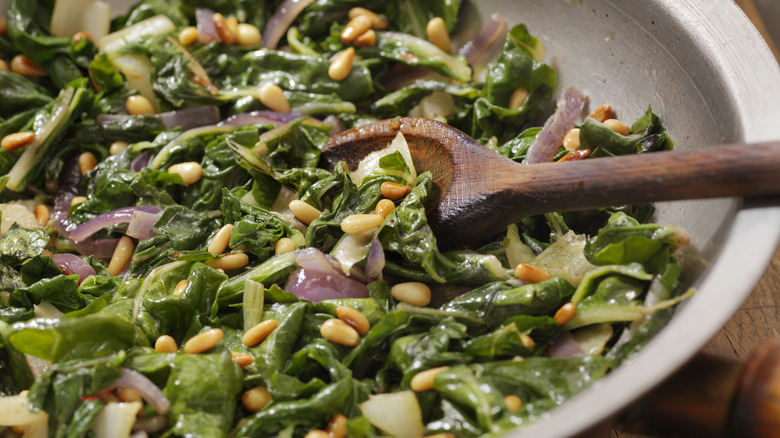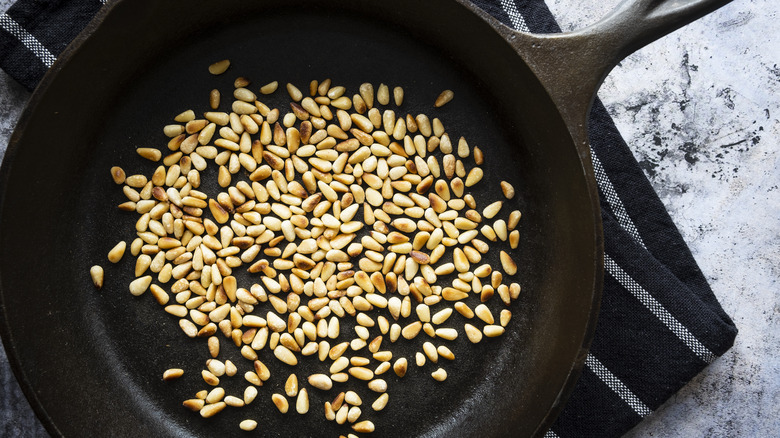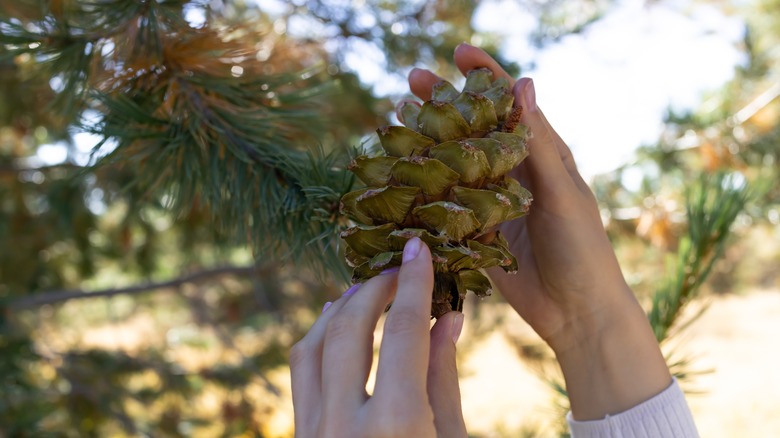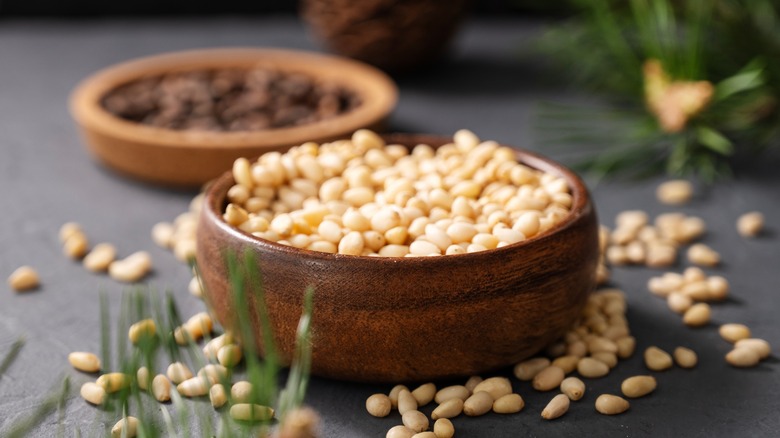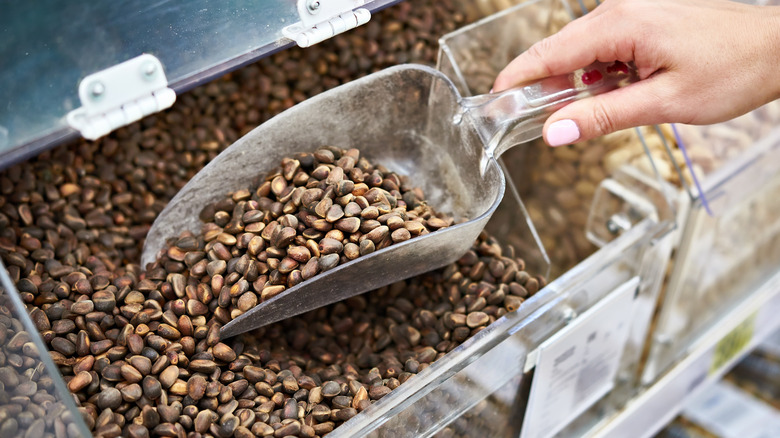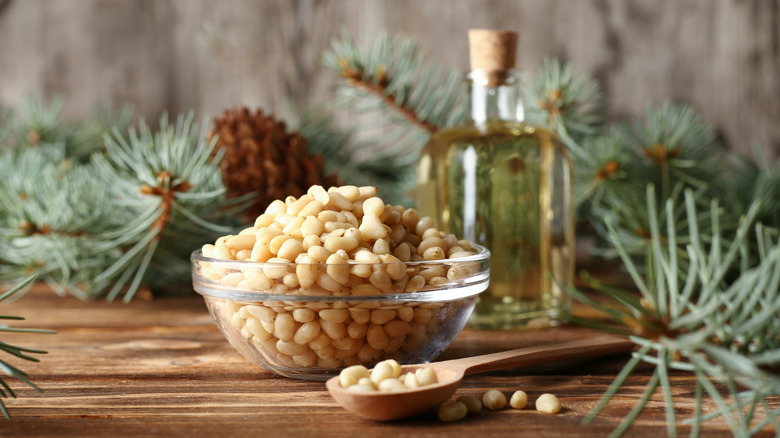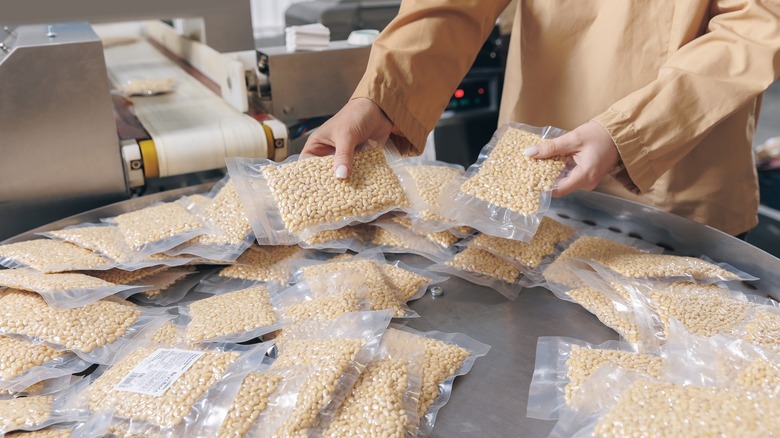The Ultimate Guide To Pine Nuts
Pine nuts are an incredibly versatile ingredient that every cook should know how to use. They're the key ingredient in everything from iconic pasta sauces to beloved desserts, yet they can also be eaten alone as a snack. They're absolutely packed with vital nutrients, protein, and healthy fat. According to Healthline, they may also promote heart health and even benefit the brain, not to mention their ability to help people with controlling their weight. Pine nuts are, in short, culinary powerhouses.
But these irresistible little gems still retain an air of mystery. Are they technically nuts, seeds, or something else entirely? You might be wondering whether or not you can collect them from the pine tree in your backyard and how long people have been using them in recipes. If these questions plague you, you're in luck: We're here to break down absolutely everything you need to know about this noble nut.
What are pine nuts?
To understand what pine nuts are, you first have to wrap your brain around the fact that, in the strictest, most scientific sense, pine nuts aren't nuts at all. They lack the outer shell that specifically distinguishes that botanical category, as do a number of other technical non-nuts, like peanuts and Brazil nuts. Rather, pine nuts are the seeds of the pine tree — and not just any old pine tree. Unless you happen to live in a few very specific places in the world, you probably can't climb the old tree in your backyard, shake down some cones, and end up with a handful of pesto-ready pine nuts. The pine nuts we know and love from salads, baked goods, and pasta come from roughly 20 specific varieties of pine.
Pine nuts are very visually distinct; once you know what they look like, you probably won't confuse them with the other offerings in the bulk nut aisle. Each nut is roughly teardrop-shaped, with certain types being longer and skinnier than others. They range in color from creamy off-white to a warm tan. Unshelled pine nuts, which certain specialty vendors offer, are clad in a dark brown shell, roughly the color of mahogany wood. Some varieties of pine nuts are larger than others, but generally speaking, they're smaller than your average peanut. Unlike striated almonds or wrinkly walnuts, they're also distinctively smooth and softer to the touch.
How are pine nuts grown and harvested?
Growing and harvesting pine nuts is an incredibly complex process. It begins, of course, with the pine tree itself. Plenty of apparently fully-grown, totally mature pine trees are not, in fact, capable of bearing pine nuts; it takes roughly 25 years for these soaring conifers to reach the point of producing any pine nuts at all, let alone producing them consistently.
A pine nut's genesis begins with that of the cone containing them. The process starts in the spring when the trees pollinate each other. The cone develops over the course of the ensuing summer and then goes into dormancy through the cooler months. As the temperatures rise once more, it becomes the sort of cone we recognize. Harvesters and foragers typically gather the cones in the fall when they're still ovoid and green. All told, the process takes about 18 months.
At this point, the real work begins. Pine nuts are wedged deep beneath a pine cone's scales, which makes them tough to extract. Thus, the harvested cones are left to dry in sun-soaked burlap sacks for 20 days to about a month. This transforms the tender green oblongs into the splayed-open cones you might recognize from the forest floor. The pine nuts are then extracted and cracked open, sometimes through smashing of the cone itself. Then, at last, the pine nuts are ready to be eaten, packaged, or sold. It's little wonder pine nuts tend to fetch such a high price — a ton of labor goes into readying them for diners' plates.
Where do pine nuts come from?
Pine nuts grow all over the world in a dizzying array of varieties. But a few places stand at the top of the heap when it comes to exporting them. Consider Afghanistan. Over the course of nine months in 2022, that nation exported at least 5,000 tons of pine nuts, most of which went to China. Indeed, pine nuts have become a key export for Afghanistan and are especially key to life in the Khost and Paktia provinces.
Russia, the world's largest supplier of pine nuts, manages to top even this impressive feat. A bumper crop of pine nuts can make an especially major impact on a region; in 2019, for example, an especially strong harvest brought people to the forests of the snowy Altai Republic, where they threw themselves into gathering, processing, and trading pine nuts. Many spent weeks in the mountains and even took time off from other jobs — that's how lucrative these tiny seeds truly are. As in Afghanistan, the bulk of Russia's pine nuts are exported to China.
The piñon pine nut holds a similarly major place in the New Mexico economy, particularly around Gallup. This sought-after variety is deeply embedded in the history and culture of the region's Indigenous peoples, having served as a key food source for centuries. Foraging for piñon is part of life, there — and when the harvest is good, hundreds of people can be found collecting, selling, buying, and simply discussing piñon. A pretty penny stands to be made in the process: In 2020, the sweet little seeds were going for $15 a pound.
How long have humans been eating pine nuts?
To many, pine nuts seem like a chic, modern ingredient. This makes a certain sort of sense when one takes contemporary food trends into consideration. Yes, pesto has been eaten for decades — specifically, since at least 1863 – but it became hugely popular within the English-speaking world in the 1980s and 1990s.
But in fact, humans have been eating pine nuts for a long, long time. Pine trees emerged as a distinct biological entity roughly 180 million years ago. Humanity began to consume them in the Paleolithic era, also known as the Old Stone Age, which began about 2.5 million years ago. A huge variety of cultures developed distinct uses of and relationships to the pine nut over the course of millennia.
Many Native American tribes of the Great Basin region, including the Shoshone, Paiute, Washo, and Ute, cultivated pine nuts as a staple crop for thousands of years and continue to do so today. A variety of processing and storage methods developed over the years, incorporating baskets, hot coals, and grinding stones. Some pine nuts were eaten as-is, while others were transformed into flour and other types of food.
Can you taste the difference between various types of pine nuts?
The average person probably hasn't sampled a wide variety of pine nuts in their life. But this variety does indeed exist, and some people claim they can taste the differences between them. Generally speaking, all pine nuts taste oily, nutty, and sweet and often boast a faint hint of pine freshness. But beyond that common ground, the distinctions emerge.
Pinus edulis pine nuts, commonly known as piñon nuts, are renowned for their taste. They're said to be extremely buttery, which makes them ideal for roasting and toasting. Pinus pinea pine nuts, in contrast, are said to taste considerably less rich, bordering on bland. Pinus koraiensis, known as the Korean pine, bears nuts with a milder taste than normal. Pine nuts from Pinus sibirica, or the Siberian pine, are incredibly rich in oil, much like the piñon. They've been described as having an enviable taste with notes of turpentine. That probably won't charm most eaters, but hey, it's hooked at least one person.
Notably, pine nut varieties with higher oil content are more prone to spoilage. If a manufacturer doesn't take care to package and ship them correctly, that can result in some seriously nasty-tasting pine nuts. So, if you've ever tried one of these varieties and found yourself disappointed, consider giving them another shot — so long as you make sure you're getting the freshest pine nuts possible.
How to cook with pine nuts
There are a ton of different ways to cook with pine nuts within a wide variety of cuisines. First and foremost, there is the ancient and modern Italian delight that is pesto. That delectable sauce deserves its place at the top of the pine nut recipe heap: It's full of flavor, incredibly versatile, and easy to make. But pesto's not the only way to add pine nuts to pasta: The next time you toss together a simple marinara, consider topping it with a handful of these ivory beauties.
Italian cuisine doesn't confine pine nuts to savory dishes, either; pignoli cookies prove they're just as tasty when added to desserts. This is probably the most famous pine nut-based sweet, and deservedly so — it's hard to beat these sugary, buttery, seed-studded delights. But it's definitely not the only option for pine nut lovers with a sweet tooth. Pine nuts are irresistible in shortbread, tarts, cake, and even pie.
More of a veggie-eater? You're in luck — pretty much everything from the garden tastes great with these powerful little seeds. Crisp fiddlehead ferns and pine nuts are a match made in culinary heaven. Spinach salads taste better, with a few scattered on top. Pine nuts' warm, unctuous flavor doesn't fail when it comes to all things veggie. Next time you're making a salad, toss a handful in — you'll probably like the results.
Should you toast your pine nuts?
Any pine nuts you buy will probably come raw. This is far from a problem; raw pine nuts are delicious. But toasting them brings a whole new level of flavor into the mix, which complements a wide range of ingredients. When toasted, pine nuts gain a warm, almost caramelized nuttiness. They're mouth-watering on their own, but they're especially delicious in breads, cookies, salads, and fresh sauces.
So, how does one go about toasting pine nuts? You have a few options. First, there's the stove. Spread the pine nuts out in a single layer on a dry skillet and cook them over medium-low heat until they've begun to turn golden and smell delicious. The key here is to keep your eyes on the skillet at all times — the difference between perfectly toasted pine nuts and burnt garbage can be a matter of seconds.
You can also toast pine nuts in the oven by pre-heating them to 350 degrees Fahrenheit, spreading them out on a baking sheet, and waiting about four minutes. This route might seem more hands-off, but in some ways, it's trickier because you still need to keep an eye on them. This will probably necessitate opening the oven door, which can interrupt the baking process. Toasting them in the microwave is similarly prone to error: You rinse the nuts in cold water, put them in a folded-down paper bag, and microwave for about one minute. If you master either technique, you're golden. If not — well, it's probably easier to use the skillet, which allows you to keep an eye on your pine nuts throughout the entire toasting process.
Is it safe to forage your own pine nuts?
Once you get hooked on pine nuts, you find yourself looking at the pine trees around you in a whole new way. Could these everyday trees hide tasty, buttery gems? The answer is probably no — only a small minority of the hundreds of different pine trees in the world bear actual pine nuts. But if you're lucky enough to live in a few specific parts of the world, then there is indeed a chance that your local conifers contain pine nuts worthy of the name. Given how expensive they tend to be, the idea of foraging for pine nuts yourself is mighty tempting.
The good news is that pine nut foraging is a fun, useful, and healthy hobby that even a novice can quickly master. First, you need to make sure the pine trees in your area bear actual pine nuts; if you're an American, you're likely out of luck if you don't live in the West. Secondly, you need to observe the rules of the region. If you're going foraging in Great Basin National Park, for example, you should only forage in the fall, take a specific amount of nuts, avoid damaging the trees, and respect a number of other key regulations.
Beyond all this, a pine nut forager must make absolutely certain they know what they're putting in their mouth. Some trees, like the yew, look a lot like pine nut-bearing varieties but are, in fact, incredibly toxic, warns Four Season Foraging. Don't go foraging without a local plant identification guide or, better yet, an expert companion with experience in pine nut hunting. If you're foraging in a national park, reach out to park rangers and other affiliated parties for help and guidance.
What is pine mouth?
Take a moment to imagine eating your favorite pine nut-laden treat, be it a moist pignoli cookie or penne laden with pesto. Good, right? Now, imagine waking up the next day with the taste of metal in your mouth. Sounds like a bizarre curse out of a fairy tale, right? But in fact, it's all too real. Welcome to the horrible world of pine mouth.
Pine mouth is a bizarre condition a minority of people develop after eating pine nuts, according to the U.S. Department of Health and Human Services. Roughly 12 to 48 hours after the pine nuts were ingested, the sufferer began to taste metal. This unpleasant effect intensifies whenever they eat something, no matter what it is. It can last for a few days, which is bad enough, but horrifyingly, it plagues some people for up to two weeks.
What causes it? Scientists aren't sure. Raw pine nuts seem to be more likely to cause pine mouth than cooked ones, but the latter category has been known to induce it. It doesn't take many nuts to set the reaction off, either — 10 to 15 are more than enough to fill a person's mouth with phantom pennies. The good news is that pine mouth eventually goes away, and it doesn't appear to have any lasting effects. But two weeks of it is definitely bad enough to be going on with.
Where to buy pine nuts
Back in the day, pine nuts were the sort of thing you had to go to a gourmet grocer to find — and only if you were lucky enough to live in the kind of area that had gourmet grocers. Today, pine nuts are a whole lot easier to get your hands on. The odds are pretty good that you can find them at whatever supermarket you already shop at: Whole Foods, Walmart, and Stop & Shop all offer pine nuts at pretty reasonable prices. This widespread availability pretty much ensures that if they're not in stock at one place, they're probably at another establishment that isn't too far away.
If you want a particular kind of pine nut, however, you'll probably need to turn to a specialty outlet. Independent grocers and ethnic markets, especially Italian ones, are particularly likely places. But the internet also offers a wide array of options for the discerning pine nut consumer. Nuts.com offers four different kinds of pine nuts, including raw, in-shell nuts for your birdfeeder. Nutstop.com sells raw pine nuts and delicate Italian pine nuts, also known as pignolas. If you're interested in the sought-after piñon variety known throughout the American Southwest, then the simply named Pinenut.com is your best bet.
Are pine nuts nutritious?
That pine nuts are delicious is not in dispute. But are they also nutritious? Given their rich flavor and general air of gourmet indulgence, you could be forgiven for assuming the answer is no. However, pine nuts are actually pretty darn good for you — and in a variety of ways at that.
Pine nuts are an excellent source of multiple micronutrients, including zinc, potassium, and magnesium. Micronutrients are essential to maintaining good health, yet a shocking number of people are deficient in at least one or two. This can lead to chronic health problems and even outright diseases; lacking magnesium, for example, is associated with type 2 diabetes and cardiovascular disease, among other potential outcomes, according to Oregon State University. Fruits and veggies are some of the best ways to get the micronutrients you need, which makes a fresh salad with pine nuts scattered on top an incredibly healthy choice of meal, as well as a mouth-watering one.
Pine nuts are also distinguished by the fact that they only contain unsaturated fatty acids. This makes them an excellent choice for anyone with coronary heart disease, suggests MDPI. As tree nuts, they're also associated with a lower incidence of cardiovascular disease among those living with diabetes, according to AHA Journals. There really is no end of reasons to pick up a bag of pine nuts the next time you see them at the store.
How to store pine nuts
The high oil content that makes pine nuts so luscious comes at a price: These glorious little nuggets go rancid more quickly than you'd expect. Too many people buy a bag of pine nuts and leave it on a pantry shelf for weeks, with the expectation that they'll be able to grab a handful here and there whenever they want a snack, a batch of fresh pesto, or a salad topping. They learn — sooner than they expect — that this is a good way to end up with a palm full of greasy, crumbling, funky-smelling nut rubble.
Proper storage is key to avoiding this. Keep your pine nuts in an airtight container in the refrigerator. Choosing to keep them in either an airtight container or the refrigerator is not enough. Authorities disagree on how long they'll last this way; some say one to two months, others say up to three. If you're within the three-month range, use your eyes, nose, and hands to judge if they're still good. You can also freeze pine nuts to keep them fresh longer, though again, sources differ on whether this can be done for three to six months or up to nine. Regardless, make sure to use a freezer-safe container.
